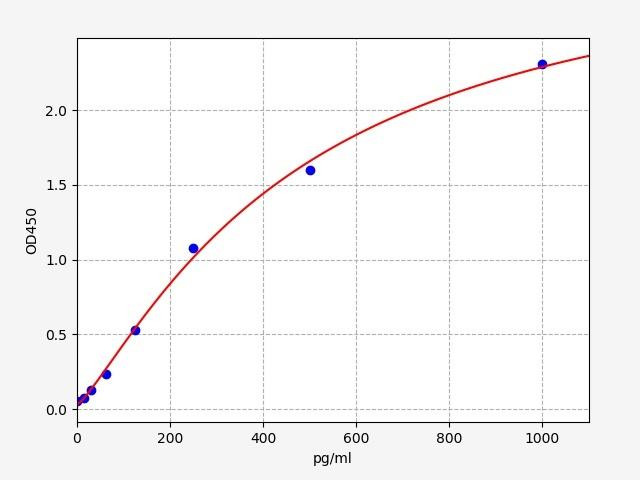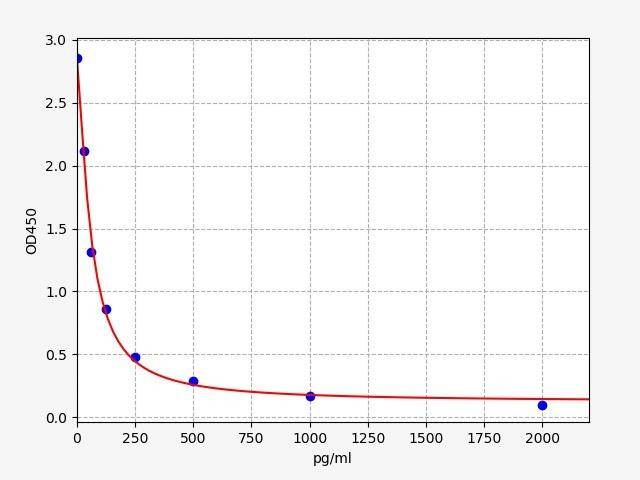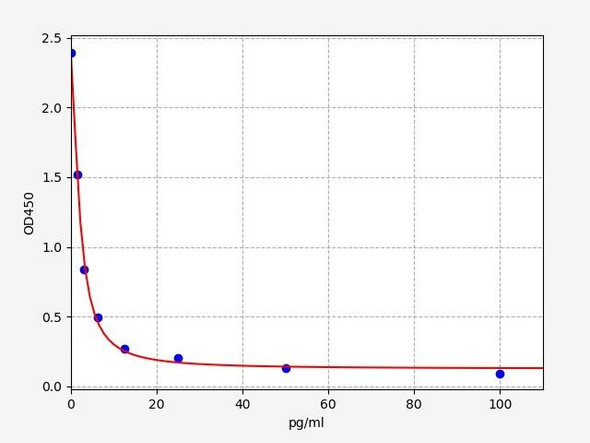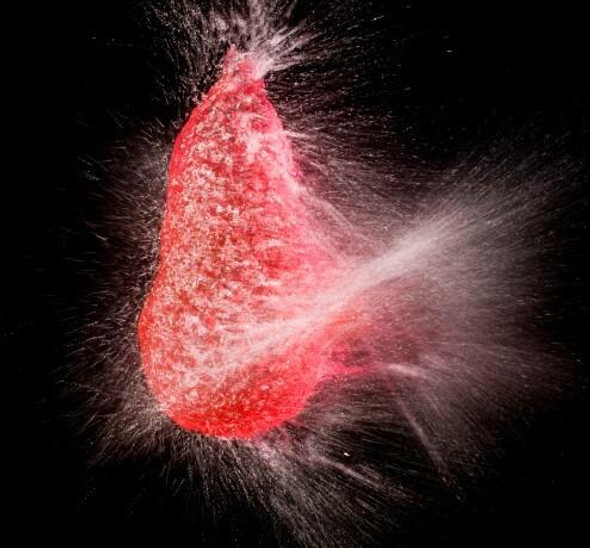TXB2 (Thromboxane B2) ELISA Kit (UNFI0094)
- SKU:
- UNFI0094
- Product Type:
- ELISA Kit
- Size:
- 96 Assays
- Sensitivity:
- 0.938pg/ml
- Range:
- 1.563-100pg/ml
- ELISA Type:
- Competitive
- Synonyms:
- TXB2
- Reactivity:
- Universal
Description
Kit Name
Intro paragraph
Key Features
| Save Time | Pre-coated 96 well plate | |
| Quick Start | Kit includes all necessary reagents | |
| Publication Ready | Reproducible and reliable results |
Overview
|
Product Name: |
TXB2 (Thromboxane B2) ELISA Kit |
|
Product Code: |
UNFI0094 |
|
Size: |
96 Assays |
|
Alias: |
TXB2 (Thromboxane B2) |
|
Detection Method: |
Competitive ELISA, Coated with Antibody |
|
Reactivity: |
Universal |
|
Sensitivity: |
< 0.938pg/ml |
|
Range: |
1.563-100pg/ml |
|
Storage: |
4°C for 6 months |
|
Note: |
For Research Use Only |
Additional Information
|
Recovery |
Matrices listed below were spiked with certain level of TXB2 (Thromboxane B2)and the recovery rates were calculated by comparing the measured value to the expected amount of TXB2 (Thromboxane B2) in samples.
|
||||||||||||||||||||
|
Linearity: |
The linearity of the kit was assayed by testing samples spiked with appropriate concentration of TXB2 (Thromboxane B2) and their serial dilutions. The results were demonstrated by the percentage of calculated concentration to the expected.
|
||||||||||||||||||||
|
CV(%) |
Intra Assay <8 Inter Assay <10 |
Kit Components
| Component | Quantity | Storage |
|
ELISA Microplate (Dismountable) |
8x12 strips |
4°C for 6 months |
|
Lyophilized Standard |
2 |
4°C/ -20°C |
|
Sample/Standard Dlution Buffer |
20ml |
4°C |
|
Biotin-labeled Antibody (Concentrated) |
120ul |
4°C (Protection from light) |
|
Antibody Dilution Buffer |
10ml |
4°C |
|
HRP-Streptavidin Conjugate (SABC) |
120ul |
4°C (Protect from light) |
|
SABC Dilution Buffer |
10ml |
4°C |
|
TMB Substrate |
10ml |
4°C (Protection from light) |
|
Stop Solution |
10ml |
4°C |
|
Wash Buffer (25X) |
30ml |
4°C |
|
Plate Sealer |
5 |
- |
Other materials required:
- Microplate reader with 450 nm wavelength filter
- Multichannel Pipette, Pipette, microcentrifuge tubes and disposable pipette tips
- Incubator
- Deionized or distilled water
- Absorbent paper
- Buffer resevoir
Protocol
*Note: Protocols are specific to each batch/lot. For the correct instructions please follow the protocol included in your kit.
Equilibrate the TMB substrate for at least 30 min at 37°C beforeuse. When diluting samples and reagents, they must be mixed completely andevenly. It is recommended to plot a standard curve for each test.
| Step | Procedure |
|
1. |
Set standard, test sample and control (zero) wells on the pre-coatedplate respectively, and then, record their positions. It isrecommended to measure each standard and sample in duplicate. Washplate 2 times before adding standard, sample and control (zero) wells! |
|
2. |
Add Sample and Biotin-detection antibody: Add 50µL of Standard, Blank or Sample per well. The blankwell is added with Sample Dilution Buffer. Immediately add 50 µL of biotin-labelled antibody workingsolution to each well. Cover with the plate sealer provided. Gently tap the plate to ensure thoroughmixing. Incubate for 45 minutes at 37°C. (Solutions are added to the bottom of micro-ELISA platewell, avoid touching plate walls and foaming). |
|
3. |
Wash: Aspirate each well and wash, repeating the process three timesWash by filling each well with Wash Buffer (approximately 350µL)using a squirt bottle, multi-channel pipette, manifold dispenser orautomated washer. Complete removal of liquid at each step is essentialto good performance. After the last wash, remove any remaining WashBuffer by aspirating or decanting. Invert the plate and pat it againstthick clean absorbent paper. |
|
4. |
HRP-Streptavidin Conjugate(SABC): Add 100µL of SABC workingsolution to each well. Cover with a new Plate sealer. Incubate for30minutes at 37°C. |
|
5. |
Wash: Repeat the aspiration/wash process for five times. |
|
6. |
TMB Substrate: Add 90µL of TMB Substrate to each well. Coverwith a new Plate sealer. Incubate for about 10-20 minutes at 37°C.Protect from light. The reaction time can be shortened or extendedaccording to the actual color change, but not more than 30minutes.When apparent gradient appeared in standard wells, you can terminatethe reaction. |
|
7. |
Stop: Add 50µL of Stop Solution to each well. Color turn toyellow immediately. The adding order of stop solution should be as thesame as the substrate solution. |
|
8. |
OD Measurement: Determine the optical density (OD Value) of each wellat once, using a microplate reader set to 450 nm. You should open themicroplate reader ahead, preheat the instrument, and set the testing parameters. |
Sample Preparation
When carrying out an ELISA assay it is important to prepare your samples in order to achieve the best possible results. Below we have a list of procedures for the preparation of samples for different sample types.
| Sample Type | Protocol |
|
Serum |
If using serum separator tubes, allow samples to clot for 30 minutes at room temperature. Centrifuge for 10 minutes at 1,000x g. Collect the serum fraction and assay promptly or aliquot and store the samples at -80°C. Avoid multiple freeze-thaw cycles. If serum separator tubes are not being used, allow samples to clot overnight at 2-8°C. Centrifuge for 10 minutes at 1,000x g. Remove serum and assay promptly or aliquot and store the samples at -80°C. Avoid multiple freeze-thaw cycles. |
|
Plasma |
Collect plasma using EDTA or heparin as an anticoagulant. Centrifuge samples at 4°C for 15 mins at 1000 × g within 30 mins of collection. Collect the plasma fraction and assay promptly or aliquot and store the samples at -80°C. Avoid multiple freeze-thaw cycles. Note: Over haemolysed samples are not suitable for use with this kit. |
|
Urine & Cerebrospinal Fluid |
Collect the urine (mid-stream) in a sterile container, centrifuge for 20 mins at 2000-3000 rpm. Remove supernatant and assay immediately. If any precipitation is detected, repeat the centrifugation step. A similar protocol can be used for cerebrospinal fluid. |
|
Cell culture supernatant |
Collect the cell culture media by pipette, followed by centrifugation at 4°C for 20 mins at 1500 rpm. Collect the clear supernatant and assay immediately. |
|
Cell lysates |
Solubilize cells in lysis buffer and allow to sit on ice for 30 minutes. Centrifuge tubes at 14,000 x g for 5 minutes to remove insoluble material. Aliquot the supernatant into a new tube and discard the remaining whole cell extract. Quantify total protein concentration using a total protein assay. Assay immediately or aliquot and store at ≤ -20 °C. |
|
Tissue homogenates |
The preparation of tissue homogenates will vary depending upon tissue type. Rinse tissue with 1X PBS to remove excess blood & homogenize in 20ml of 1X PBS (including protease inhibitors) and store overnight at ≤ -20°C. Two freeze-thaw cycles are required to break the cell membranes. To further disrupt the cell membranes you can sonicate the samples. Centrifuge homogenates for 5 mins at 5000xg. Remove the supernatant and assay immediately or aliquot and store at -20°C or -80°C. |
|
Tissue lysates |
Rinse tissue with PBS, cut into 1-2 mm pieces, and homogenize with a tissue homogenizer in PBS. Add an equal volume of RIPA buffer containing protease inhibitors and lyse tissues at room temperature for 30 minutes with gentle agitation. Centrifuge to remove debris. Quantify total protein concentration using a total protein assay. Assay immediately or aliquot and store at ≤ -20 °C |
|
Breast Milk |
Collect milk samples and centrifuge at 10,000 x g for 60 min at 4°C. Aliquot the supernatant and assay. For long term use, store samples at -80°C. Minimize freeze/thaw cycles. |
TBX2 Background
What is Thromboxane B2 (TXB2)?
Thromboxane B2 (TXB2) is a metabolite derived from the breakdown of thromboxane A2 (TXA2), which is a bioactive lipid mediator belonging to the prostanoid family. Prostanoids are a class of signaling molecules derived from arachidonic acid and play diverse roles in various physiological and pathological processes.
Thromboxane Production
The gene responsible for the synthesis of TXB2 is known as TBXAS1, which encodes the enzyme thromboxane synthase. Thromboxane synthase catalyzes the conversion of the unstable intermediate prostaglandin H2 (PGH2) into thromboxane A2 (TXA2), which subsequently undergoes rapid enzymatic degradation to form TXB2.
Thromboxane B2 (TXB2) Structure
TXB2 is a stable, non-active metabolite of TXA2. Structurally, it consists of a six-membered cyclic ring with a carboxylic acid group (COOH) attached at one end. It retains the characteristic pentane ring structure of the prostanoid family.
Space filling model of the 3D structure of Thromboxane b2. Source: PubChem
Thromboxane B2 (TXB2) Function
TXB2 is biologically inactive, in contrast to its parent molecule, TXA2, which has potent biological effects. Thromboxane A2 functions as a vasoconstrictor, promotes platelet aggregation, and facilitates blood clot formation. However, once TXA2 is released into the circulation, it undergoes rapid metabolism to TXB2, losing its biological activity.
Thromboxane B2 (TXB2) Clinical Significance
TXB2, as a metabolite, is relatively stable and can be measured more reliably compared to its parent molecule, TXA2, which is highly reactive and rapidly metabolized. The measurement of TXB2 levels thus serves as an important marker for assessing platelet activation and thromboxane production in various clinical contexts. Elevated levels of TXB2 are often associated with increased platelet activation, which can contribute to the development of cardiovascular diseases, thrombotic disorders, and inflammatory conditions.
TXB2 FAQs
Q: What is the purpose of the TXB2 ELISA kit?
The Thromboxane B2 ELISA Kit is designed for the quantitative measurement of Thromboxane B2 (TXB2) levels in various biological samples. It is commonly used in research studies to assess platelet activation and thromboxane production in diverse experimental settings.
Q: What sample types can be used with this kit?
This ELISA kit is compatible with a wide range of sample types, including plasma, serum, urine, and cell culture supernatants. Proper sample collection and preparation protocols should be followed as outlined in the kit's user manual to ensure accurate and reliable results.
Q: Can this kit be used for diagnostic purposes in clinical samples?
No, the Thromboxane B2 ELISA Kit is intended for research purposes only and is not validated for diagnostic or clinical use. It is designed to provide accurate measurements and reliable data for experimental investigations in a research laboratory setting
Q: Which species is this Thromboxane B2 ELISA Kit compatible with?
The Thromboxane B2 ELISA Kit is designed to be compatible with a wide range of species, including human, mouse, rat, and other relevant animal models commonly used in research. This versatility allows researchers to investigate Thromboxane B2 levels in different species, facilitating comparative studies and expanding the kit's applications.
Q: Where can I find additional technical support or assistance with the Thromboxane B2 ELISA kit?
For any technical inquiries or assistance regarding the Thromboxane B2 ELISA kit, you can reach out to our team. They will be available to answer your questions and provide the necessary guidance to ensure a successful experiment.
Related Products

| Human Thromboxane A2 receptor / TXA2R ELISA Kit | |
|---|---|
| ELISA TYPE: | Sandwich ELISA, Double Antibody |
| SENSITIVITY: | 0.094ng/ml |
| RANGE: | 0.156-10ng/ml |

| Human Soluble P-Selectin / Sselp ELISA Kit | |
|---|---|
| ELISA TYPE: | Sandwich ELISA, Double AntibodySENSITIVITY: |
| SENSITIVITY: | 9.375pg/mlRANGE: |
| RANGE: | 15.625-1000pg/ml |

| PGE2 ELISA Kit | |
|---|---|
| ELISA TYPE: | Competitive ELISA, Coated with Antigen |
| SENSITIVITY: | 18.75pg/ml |
| RANGE: | 31.25-2000pg/ml |






